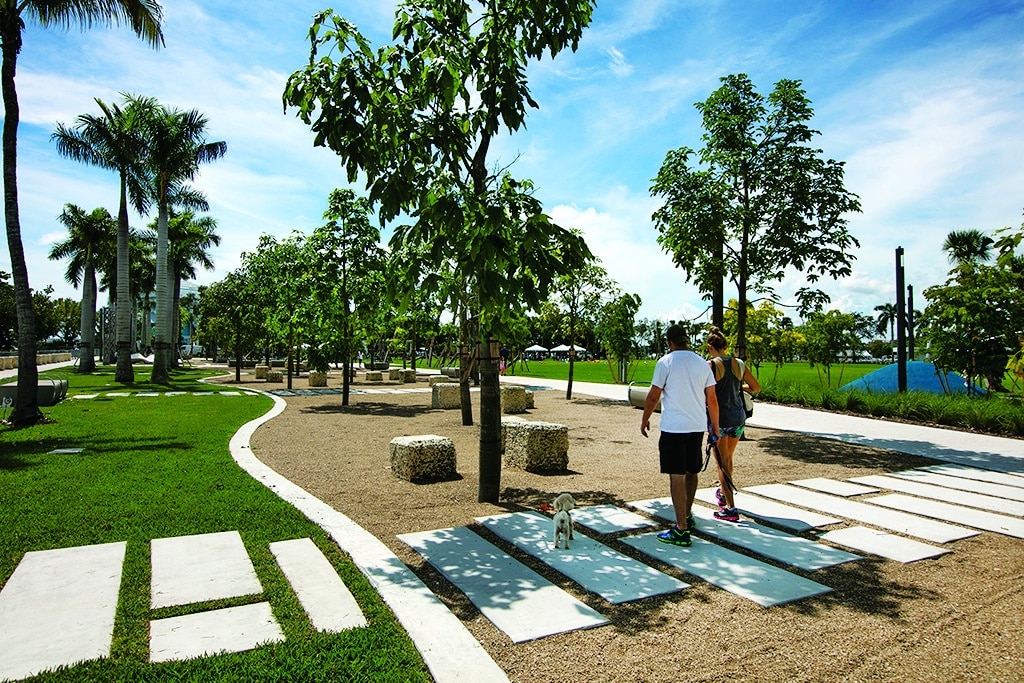
Olympic and Paralympic hopefuls love training in Miami over the winter. In January, the city of Miami reciprocated that love by opening Regatta Park in time to host the Sailing World Cup Miami. For the first time in more than two decades, all fleets launched from boat parks along the Coconut Grove shoreline.
Many sailors had given up on the multimillion-dollar Regatta Park project, which was proposed in 2008 as part of a comprehensive shoreline improvement. But by scaling down the original plan, the city was able to open the area to the public in the fall of 2015. The World Cup was the first regatta on its schedule.
Seven acres of grass and pathways replaced the decrepit Coconut Grove Exposition Center, providing a venue to house 49er, FX and Nacra 17 classes. In previous SWC events, the skiffs and cats sailed out of the Miami Rowing Club on Virginia Key, several miles away by either boat or car. By geographically linking the disjointed fleets at the US Sailing Center and Coconut Grove Sailing Club, it’s now possible to visit all of the event’s boat parks in a half-hour waterfront stroll.
“Regatta Park is magic,” says SWC co-chair Gary Bodie. “That a city would take such prime real estate, turn it into a green space, and call it Regatta Park, and include in their design that it’s a facility for hosting regattas — that’s unheard of in the United States.”
Yet open space and landscaping aren’t all that’s needed to host a regatta. A planned floating ramp off of the seawall is not yet in place, so the three fleets launched on two concrete ramps, which the city closed to public launching during two weeks of training and racing. The ramps are narrow for the cats, however. “You can’t turn the boats, so you have to be really careful,” says Team GBR Nacra 17 coach Maurice Paardenkooper. “An extra ramp, a floating one, and we would get a bit easier on and off the dock.”
That said, Paardenkooper likes the new location. “It’s actually a nice boat park,” he says. “And also everything is quite close by — Starbucks and a Fresh Market.”
The city’s long-term plan is to build a community center adjacent to Regatta Park, which Bodie says could be used as a regatta headquarters. “World Sailing has always wanted a more centralized feel for Sailing World Cup events,” he says, “and this will fulfill that requirement.”
For 2016, regatta headquarters remained at the US Sailing Center, which made the new park feel more like a boat storage area than the beating heart of regatta central, but by January 2017, that may all change again.
“Once we go to the 40-boat quota in each class next year,” Bodie explains, “it becomes possible to host the whole thing at Regatta Park.” World Sailing has established 40 as the maximum fleet size for every Sailing World Cup event beginning in 2017.
The city of Miami plans to install hoists as well, but with no money in its coffers, that remains a wish-list item. One element of the redevelopment that sailors are disappointed about is potentially losing Scotty’s Landing, the only area restaurant on the water with sailor-friendly prices. Its rough-boarded picnic tables and casual ambience are still intact, but it’s only a matter of time before it’s razed to make way for Grove Harbor, an updated mall-dining complex.









